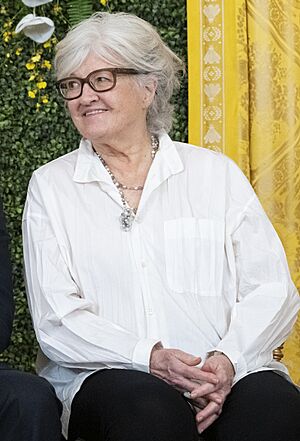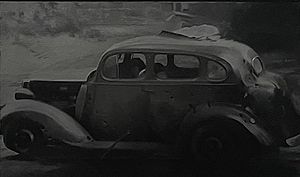Vija Celmins facts for kids
Quick facts for kids
Vija Celmins
|
|
|---|---|
 |
|
| Born |
Vija Celmiņa
October 25, 1938 |
| Nationality | American |
| Education | John Herron School of Art UCLA |
| Known for | Painting, Graphic art, Printmaking |
| Movement | Abstract, Minimalism, Photorealism |
| Awards | Guggenheim Fellowship, National Endowment for the Arts, American Academy of Arts and Letters, Carnegie Prize, MacArthur Fellowship |
Vija Celmins (pronounced VEE-yuh SEL-muns) is a famous artist known for her incredibly realistic paintings and drawings. She often creates art that looks exactly like photographs of nature. Her favorite subjects include the ocean, spider webs, starry skies, and rocks.
Earlier in her career, Vija Celmins also made sculptures inspired by Pop art. She also created paintings that used only one color, but still showed real objects. Today, she lives in New York City. Her art has been shown in many museums around the world. These include the Museum of Modern Art and the Whitney Museum of American Art.
Contents
Biography of Vija Celmins
Vija Celmins was born on October 25, 1938, in Riga, Latvia. When she was very young, her family had to leave their home. This was during World War II, when the Soviet Union took over Latvia. Her family first went to Germany. After the war, they lived in a refugee camp for Latvians.
In 1948, when Vija was ten, her family moved to the United States. They lived briefly in New York City, then settled in Indianapolis, Indiana. Vija did not speak English at first. This made her focus on drawing. Her teachers saw her talent and encouraged her to keep creating art.
Early Art Training
In 1955, Vija Celmins started studying at the John Herron School of Art in Indianapolis. She felt like she finally belonged there. In 1961, she won a special scholarship to attend Yale University for a summer. There, she met other artists like Chuck Close and Brice Marden, who became her lifelong friends.
During this time, she studied the work of an Italian painter named Giorgio Morandi. He was known for his simple, one-color still life paintings. Vija also started painting abstract art. In 1962, she earned her degree from Herron. She then moved to Venice, Los Angeles, to continue her art studies at the University of California at Los Angeles (UCLA). She graduated from UCLA in 1965.
Life and Work in California
Vija Celmins lived in Venice, California, until 1980. She spent her time painting and making sculptures. She also taught art at several universities. These included California State University, Los Angeles and California Institute of the Arts.
In 1978, she was an artist-in-residence at the Los Angeles Institute of Contemporary Art. This meant she had a special place to work and create art.
Moving to New York City
In 1981, Vija Celmins moved to New York City for good. She wanted to be closer to other artists and the art she admired. She also started painting again after twelve years. During those years, she mostly worked with pencils. Later, she also used woodcuts, erasers, and charcoal in her art.
Since then, she has worked from a small cottage in Sag Harbor, New York. She also has a studio in Soho, Manhattan. In the 1980s, she taught art at the Cooper Union and the Yale University School of Art.
Vija Celmins' Artworks

In the 1960s, while living in California, Vija Celmins created her early artworks. These included very realistic paintings and sculptures inspired by pop art. She often painted everyday objects like TVs, lamps, pencils, and erasers. She also made paintings that looked like black and white photos.
Some of her early paintings had themes of violence or conflict. For example, she painted war planes and handguns. Artists like Malcolm Morley and Jasper Johns influenced her during this time.
Focus on Realistic Drawings
From the late 1960s through the 1970s, Vija Celmins stopped painting for a while. She focused on creating highly detailed drawings using graphite pencil. These drawings were based on photographs of natural things. She drew the surface of the ocean, the Moon, the inside of shells, and close-ups of rocks.
Her careful and detailed way of working is often compared to artists like Chuck Close and Gerhard Richter. She also admired Giorgio Morandi, who was a master of pale, grey still life paintings. Her drawings often look very real, almost like a random photo. This makes it seem like the choice of image wasn't important, but it was.
Return to Sculpture and Painting
From 1976 to 1983, Celmins also returned to making sculptures. She created a series of bronze sculptures that looked exactly like real stones. She found these stones along the Rio Grande in New Mexico. The Museum of Modern Art has eleven of these unique stone replicas.
By 1981, she started painting again. She also began working with woodcuts and other printing methods. She used charcoal a lot, often removing darkness from her images to create subtle grey tones.
Later Works: Stars, Oceans, and Spider Webs
Since the early 1980s, Celmins has focused on subjects like constellations, the moon, and oceans. She uses different techniques, balancing abstract ideas with photorealism. Around the year 2000, she started creating amazing spider web artworks. These were often negative images, made with oil paint or charcoal.
Critics praised her careful work and how her art seemed to glow. Vija Celmins says all her works are based on photographs. She puts a lot of effort into building up the surfaces of her images.

Many people have noticed that Celmins' works since the late 1960s often don't have a clear reference point. For example, her moonscapes or ocean surfaces don't show a horizon or any landmarks. This makes them feel endless and mysterious.
From 2008, Celmins started painting objects again, like maps and books. She also made many small graphite tablets that look like handheld blackboards. She has also created new series of prints featuring her famous waves, spider webs, and desert floors. Her woodcuts of water can take a year to carve. She says they remind us of "the complexity of the simplest things."
Art Exhibitions
Vija Celmins' art has been shown in over forty solo exhibitions around the world since 1966. She has also been part of hundreds of group exhibitions. Her art is currently shown by the Matthew Marks Gallery.
In 2020, a big exhibition called Vija Celmins was organized by the Metropolitan Museum of Art in New York. Between 1992 and 1994, the Institute of Contemporary Art, Philadelphia, organized a show about her career. This show traveled to several other museums, including the Whitney Museum of American Art.
Group Exhibitions
In 2022, the Hammer Museum in Los Angeles held an exhibition called Joan Didion: What She Means. Vija Celmins' artworks were included alongside those of 50 other artists. In 2023, the Hamburger Kunsthalle in Germany hosted an exhibition called Vija Celmins | Gerhard Richter. Double Vision. This show featured a conversation between the works of Vija Celmins and Gerhard Richter.
Famous Artworks in Public Collections
Many of Vija Celmins' important artworks are held in public collections. This means you can see them in museums around the world.
- Heater (1964) Whitney Museum, New York
- Torso (1964), Menil Collection, Houston
- House #1 (1965), Museum of Modern Art, New York
- Forest Fire (1965-1966), Glenstone, Potomac, Maryland
- Explosion at Sea (1966), Art Institute of Chicago
- Flying Fortress (1966), Museum of Modern Art, New York
- German Plane (1966), Modern Art Museum of Fort Worth, Texas
- Pencil (1966), National Gallery of Art, Washington, D.C.
- Suspended Plane (1966), San Francisco Museum of Modern Art
- Tulip Car #1 (1966), National Gallery of Art, Washington, D.C.
- Untitled (Double Moon Surface) (1969), Hirshhorn Museum and Sculpture Garden, Smithsonian Institution, Washington, D.C.
- Untitled (Ocean) (1969), Philadelphia Museum of Art
- Untitled (Cassiopeia) (1973), Baltimore Museum of Art
- Untitled (Medium Desert) (1974-1975), Menil Collection, Houston
- Untitled (Comb) (1978), Los Angeles County Museum of Art
- To Fix the Image in Memory (1977-1982), Museum of Modern Art, New York
- Alliance (1982), High Museum of Art, Atlanta
- Strata (1983), Metropolitan Museum of Art, New York
- Untitled (Comet) (1988), National Gallery of Art, Washington, D.C.
- Night Sky #12 (1995-1996), Carnegie Museum of Art, Pittsburgh
- Night Sky #19 (1998), Tate, London
- Untitled #17 (1998), Centre Pompidou, Paris
- Night Sky #20 (1999), Kunstmuseum Winterthur, Winterthur, Switzerland
- Night Sky #17 (2000-2001), Modern Art Museum of Fort Worth, Texas
- Blackboard Tableau #1 (2007-2010), San Francisco Museum of Modern Art
- Blackboard Tableau #14 (2011-2015), Glenstone, Potomac, Maryland
In 2005, a major art collector named Edward R. Broida gave 17 of her artworks to the Museum of Modern Art. These pieces covered 40 years of her career.
Awards and Honors
Vija Celmins has received many awards for her amazing contributions to art:
- 1961: Fellowship to Yale University Summer Session
- 1968: Cassandra Foundation Award
- 1971 & 1976: Artist's Fellowship from National Endowment for the Arts
- 1980: Guggenheim Fellowship
- 1996: American Academy of Arts and Letters Award in Art
- 1997: Skowhegan Medal for Painting
- 1997: John D. and Catherine T. MacArthur Fellowship
- 2000–2001: Coutts Contemporary Art Foundation Award
- 2004 Elected into the National Academy of Design
- 2006: RISD Athena Award for Excellence in Painting
- 2008: Awarded the $10,000 Carnegie Prize
- 2009: Roswitha Haftmann Prize
- 2009: Fellow Award in the Visual Arts from United States Artists
- 2021: Honoree of the Great Immigrants Award, Carnegie Corporation of New York

